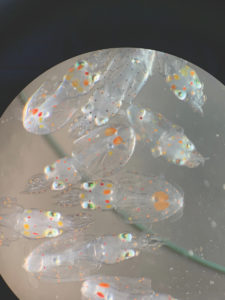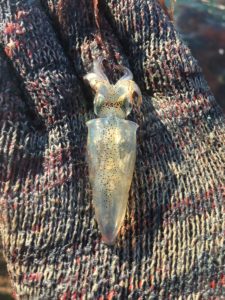Squid appeared maybe 700 million years ago. They predate everything we think of as ancient — sharks, fish, and even trees. But they don’t predate sex. That invention happened about 1.2 billion years ago. Which, along with some savvy marketing, brings us to Valentine’s Day as we know it.

How do squid celebrate their love?
During spring and summer, females gather in large spawning sites. Since females will mate many times, males compete for their attention. It is unknown whether the fact that squid have three hearts contributes to their passionate behavior. But when they have the opportunity, males rely on a specialized part of an arm — the hectocotylus — to deliver their sperm to the females. Some species go so far as to wrench off the arm and present it to the females, but our local squid play it cooler than that.
The sperm await in the female’s mantle until she ovulates. The eggs are fertilized as they pass by well-placed sperm.
The male squid does not have to be nearby at that particular moment, though he usually is, guarding his sweetheart as males do in the pas de deux of squid.
Do you remember that guy in high school who would post up at the dance and wait quietly for his shot at the girl of his dreams while she danced with some other meathead? He’d hope for them to encounter a temporary setback in their amore, and then he’d be there to console her, like the champ he was.
Squid have that guy, too. Scientists call him the “sneaker” male.
When a large male is distracted by any of a number of annoyances, including other large males that may be thinking of sharing their sperm with the female, the smaller, quicker squid may sneak right past him. Genetic tests show this strategy to be effective, yielding approximately 20 percent of squid offspring, with the balance going to the large male.
The females secrete a substance that coats the fertilized eggs. It takes on some seawater and expands in volume, protecting the eggs and also helping them get attached to a rock or the ocean floor.
Wellfleet shellfisherman Richard Blakely tells the story of arriving at his oyster grant a few summers back to find his rebar oyster cages crushed beyond repair under the weight of a giant mass of squid eggs. Richard’s cages were strong enough to support his weight when he walked on them. “Musta been 300 pounds of squid eggs,” he said.
Squid lay eggs all around our coast in the summer. Owen Nichols of the Center for Coastal Studies tells me that Pleasant Bay is a favorite squid trysting spot. Last summer, Owen and his team found many rotten squid eggs in the bay. He suspects this was due to low oxygen levels in the water from fertilizer runoff. It caused an algae bloom, an emerging problem in these parts. Still, even amidst these die-offs, many survived, as evidenced by the juveniles he found to study and as summer’s catch in Nantucket Sound showed.

Squid reproduce in large numbers and a typical brood can have hundreds of thousands of eggs. Not all of them make it. Squid love stories are brief. Though some species may live longer, the squid that visit our shores survive for only about a year — they pretty much mate and die.
But hope springs eternal. The squid born last summer are today holed up about 200 miles offshore somewhere near the continental shelf, doing what squid do while they wait for the chance to come back and visit us at MacMillan Wharf come late spring.



